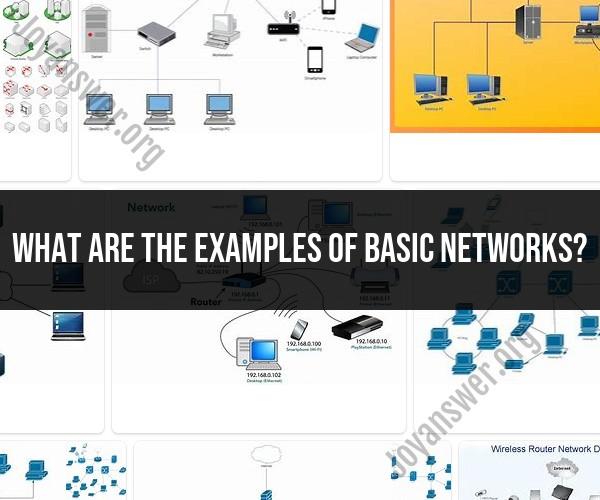What are the examples of basic networks?
Basic network configurations are simplified setups that illustrate fundamental networking concepts. Here are some examples of basic network configurations:
Peer-to-Peer Network:
- Description: In a peer-to-peer (P2P) network, devices are connected directly to one another without a central server.
- Use Case: Commonly used for small-scale file sharing between computers or devices in a home or small office.
- Example: Two laptops connected via Wi-Fi for sharing files.
Client-Server Network:
- Description: In a client-server network, multiple client devices connect to one or more central servers.
- Use Case: Used in businesses and organizations where centralization of resources and services is necessary.
- Example: Multiple computers in an office connecting to a central file server for data storage.
Local Area Network (LAN):
- Description: A LAN is a network that spans a small geographic area, such as a single building or office.
- Use Case: Used for connecting devices within a limited physical area.
- Example: Computers and printers in a home office connected via Ethernet or Wi-Fi.
Wireless Local Area Network (WLAN):
- Description: A WLAN uses wireless communication protocols (Wi-Fi) to connect devices within a specific area.
- Use Case: Provides wireless connectivity within homes, offices, and public spaces.
- Example: Wi-Fi routers providing internet access to laptops and smartphones in a coffee shop.
Home Network (HAN):
- Description: A home network connects devices within a household.
- Use Case: Used for sharing resources like printers, internet access, and media streaming among family members.
- Example: Smartphones, tablets, laptops, and smart TVs connected via a home Wi-Fi network.
Intranet:
- Description: An intranet is a private network based on internet technologies, used within an organization.
- Use Case: Provides a secure platform for sharing information and resources among employees.
- Example: An organization's internal website accessible only to employees.
Extranet:
- Description: An extranet extends network access to authorized external users, such as business partners or customers.
- Use Case: Used for secure collaboration and sharing of specific information with external entities.
- Example: A supplier portal that allows suppliers to access order information.
Virtual Private Network (VPN):
- Description: A VPN creates a secure, encrypted network connection over the internet.
- Use Case: Provides secure remote access to a private network, often used for remote work.
- Example: Employees connecting to their company's network from home via a VPN client.
These basic network configurations serve as building blocks for more complex network structures. The choice of configuration depends on the specific needs of the users and the scale of the network.













